Technical Sciences P1 Grade 12 Questions - NSC Exams Past Papers and Memos September 2019 Preparatory Examinations
Share via Whatsapp Join our WhatsApp Group Join our Telegram GroupINSTRUCTIONS AND INFORMATION
Read the following instructions carefully before answering the questions.
- Write your FULL NAME and SURNAME in the appropriate spaces on the ANSWER SHEET.
- Answer ALL the questions.
- Start each question on a NEW page in the ANSWER BOOK.
- You may use a non-programmable calculator.
- You may use appropriate mathematical instruments.
- Number the answers correctly according to the numbering system used in this question paper.
- Show ALL formulae and substitutions in ALL calculations.
- Round off your FINAL numerical answers to a minimum of TWO decimal places.
- Give brief motivations, discussions et cetera where required.
- You are advised to use the attached DATA SHEETS.
- Write neatly and legibly.
QUESTIONS
QUESTION 1
Various options are provided as possible answers to the following questions. Choose the answer and write only the letter (A–D) next to the question numbers (1.1–1.10.) in the ANSWER BOOK, for example 1.12 A.
1.1 The Law which states that an object will remain in its state of rest or continue moving with constant velocity unless it is acted upon by an unbalanced force is called …
- Lenz’s law.
- Newton’s first law.
- Newton’s second law
- Newton’s third law. (2)
1.2 An object of mass ‘m’ rests on a rough horizontal surface. A force F is applied causing the object to accelerate with magnitude ‘a’ as shown in the figure.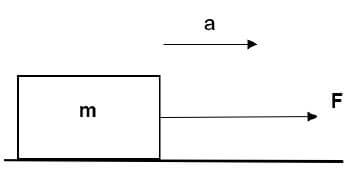
Which ONE of the following changes can be made to decrease the acceleration?
- Increase the magnitude of the applied force.
- Decrease the magnitude of the applied force.
- Decrease the mass of the object.
- Place the object on a smooth surface. (2)
1.3 An object’s velocity increases from v to 2v by applying a force.
The object’s momentum will be …
- halved.
- doubled.
- tripled.
- increased four times. (2)
1.4 Two identical trolleys are held together with a compressed spring as shown in the figure.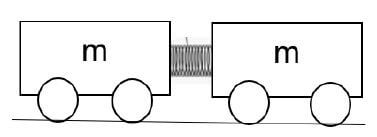
Which ONE of the following statements is TRUE about the magnitude of the momentum and velocity of the trolleys after the spring is released?
- Momentum and velocities of both trolleys are different.
- Momentum and velocities of both trolleys are the same.
- Both trolleys have the same velocity but different momentum.
- Both trolleys have the same momentum but different velocities. (2)
1.5 A constant force F of 50 N acts at an angle 30° with the horizontal and displaces a box by 8 m over a rough horizontal surface where the force of friction is 7 N.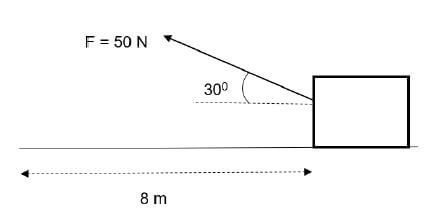
The work done, in Joule, by the vertical component of force F on the box is …
- 0.
- 200.
- 346,4.
- 400. (2)
1.6 In an experiment learners investigate the effect of depth on the pressure of a liquid. The learners allow water to spray out of holes (A, B, C and D) of equal diameter opened along the sides of a container as shown below.
One of the holes sprays out water the furthest, to point P.
From which hole will the water reach the furthest point P? 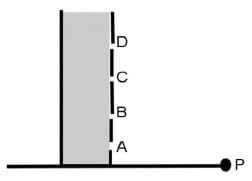 (2)
(2)
1.7 The maximum force that can be applied to a body so that the body regains its original form completely on removal of the force is called …
- stress.
- elastic limit.
- reforming force.
- deforming force. (2)
1.8 Which ONE of the following factors DOES NOT affect the capacitance of a capacitor?
- Area of the plates
- Time of flow of charge
- Distance between the plates
- Dielectric material used between the plates (2)
1.9 The process of producing electricity from motion is called …
- doping.
- etching.
- electrolysis.
- electromagnetic induction. (2)
1.10 A device that converts electrical energy to mechanical energy is a(n) …
- transistor.
- electric motor.
- electric heater.
- electric generator. (2) [20]
QUESTION 2
2.1 Two trolleys, A and B, are connected by a light string as shown in the diagram below. Force F is applied on trolley A and the trolley system accelerates at 0,3 m.s-2. The mass of trolley A is 20 kg and trolley B is 10 kg.
The trolleys are pulled over a frictionless surface.
2.1.1 State Newton’s second law in words. (2)
2.1.2 Name all the forces acting on trolley B. (3)
2.1.3 Calculate the tension T on the string. (3)
2.1.4 Draw a free body diagram of all the forces acting on trolley A. (4)
2.1.5 Calculate the magnitude of force F. (4)
2.1.6 How would the tension T on the string change if the applied force F is increased? Write only INCREASE, DECREASE or REMAINS THE SAME. (1)
2.1.7 How would the acceleration of trolley A change if trolley B is detached by breaking the string while keeping the applied force F constant? Write only INCREASE, DECREASE or REMAINS THE SAME. (1)
2.2 The ring of spring balance B is fixed on a wall and spring balance A is attached to the hook of spring balance B. The ring of spring balance A is pulled to the left and it shows a reading of 3 N.
2.2.1 Write down any TWO sets of action-reaction pairs that act in the horizontal plane in the diagram. (4)
2.2.2 What is the reading on spring balance B? (2)
2.2.3 Name and state in words the law used to answer QUESTION 2.2.2. (3) [27]
QUESTION 3
3.1 A rigid ball of mass, 60 g, is dropped from a certain height above the ground. The ball strikes the ground with a velocity of 14 m.s-1.
The ball is in contact with the ground for 0,01 s and rebounds vertically up with a velocity of 8 m.s-1.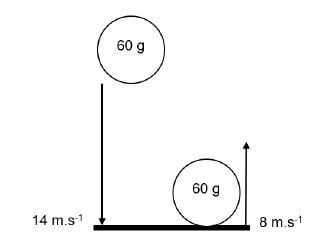
3.1.1 Define the term impulse. (2)
3.1.2 Calculate the magnitude of the force exerted by the ball on the ground. (4)
3.1.3 Write down the magnitude of the force exerted by the ground on the ball. (1)
3.1.4 The contact time is increased by replacing the rigid ball with a soft ball for the same change in momentum. How would the magnitude of the force exerted by the soft ball on the ground compare to the magnitude of the force exerted by the rigid ball? Write down only HIGHER, LOWER or REMAINS THE SAME. (1)
3.2 Give THREE applications of impulse in the context of road safety. (3)
3.3 A car of mass 1 000 kg is moving due east with a momentum of 5000 kg.m.s-1 collides with a stationary truck of mass 1 500 kg.
After the collision the car moves west with a momentum of 500 kg.m.s-1.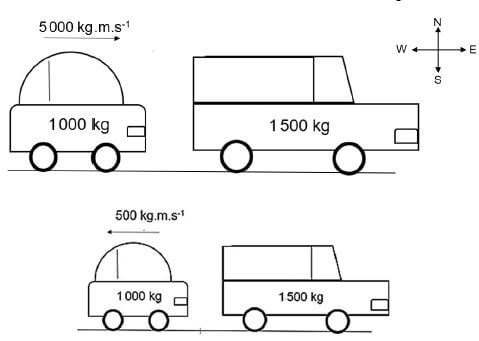
Consider the system as isolated.
3.3.1 Define the term isolated system. (2)
3.3.2 Calculate the magnitude of total momentum before the collision. (2)
3.3.3 What is the magnitude of the total momentum after the collision? (1)
3.3.4 State the principle of conservation of momentum in words. (2)
3.3.5 Calculate the velocity of the truck after the collision. (3)
3.3.6 Determine, by using a calculation, whether this collision is elastic or inelastic. (7) [28]
QUESTION 4
4.1 A block of mass 0,2 kg slides down a frictionless surface past point A at a speed of 1,5 m.s-1. The gravitational potential energy of the block at point A is 60 J. The block reaches point C, which is 4,5 m above the ground.
4.1.1 Define mechanical energy. (2)
4.1.2 At which point on the path of the block is its speed the greatest? Write down only A, B or C. (1)
4.1.3 State the principle of conservation of mechanical energy in words. (2)
4.1.4 Calculate the speed of the block at point B. (6)
4.2 The diagram given below shows the force diagram of all the forces acting on a box that is pulled by a girl with a force, Fgirl, of 42 N. The box moves 3 m horizontally to the right across a rough surface. The magnitude of force F3 is equal to 1,8 N.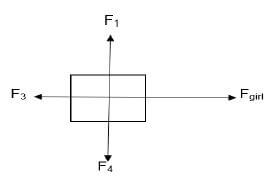
4.2.1 Identify the force that does:
- Negative work on the block (1)
- Positive work on the block (1)
4.2.2 Calculate the net work done on the block. (4)
The rate at which work is done by the girl to move the block 3 m is 400 W.
4.2.3 Give a term for the underlined phrase. (1)
4.2.4 Without using a calculation, how long does the block take to move 3 m? (2) [20]
QUESTION 5
Learners perform an investigation into the relationship between stress and strain and obtain the following graph.
Graph of Stress vs Strain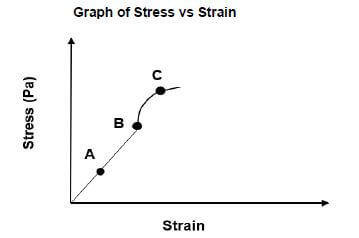
5.1
5.1.1 Define a perfectly plastic body. (2)
5.1.2 What does the gradient of the graph represent? (1)
5.1.3 At which point (A, B or C) is the elastic limit reached? (1)
Which point (A, B or C) lies in the:
5.1.4 Elastic region? (1)
5.1.5 Plastic region? (1)
5.2 The diagram shown below shows a hydraulic lift used to lift cars. A force of 300 N is exerted on a small circular piston of radius 13 cm to lift a car placed on a large piston as shown in the diagram below. Pressure is transmitted through a hydraulic fluid to the large piston.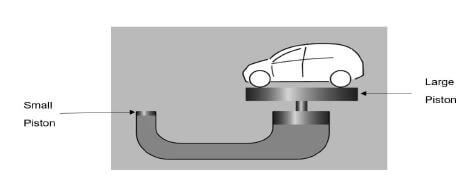
5.2.1 State Pascal’s law in words. (2)
5.2.2 Calculate the area of the large circular piston, if a minimum force of 18 000 N is required to lift the car. (6) [14]
QUESTION 6
6.1 What is the function of a capacitor? (2)
6.2 Give any TWO uses of a capacitor in technology. (2)
6.3 A battery of emf 5 V is connected to the parallel plates of a capacitor with capacitance 10 µF. Calculate the charge stored on the plates. (3)
6.4 An intrinsic semi-conductor is doped with an impurity element boron.
6.4.1 What is a semi-conductor? (2)
6.4.2 Give TWO examples of semi-conductors. (2)
6.4.3 What type (n-type or p-type) of semi-conductor is produced in the above process? (2) [13]
QUESTION 7
In the circuit diagram below the battery has an emf of 12 V. Lamps are connected as shown and Lamp 2 and Lamp 3 are identical.
The resistance of the connecting wires and battery may be ignored.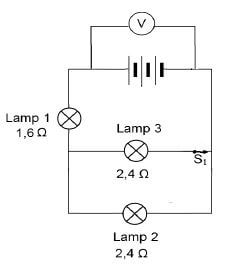
7.1. State Ohm’s law in words. (2)
7.2. Calculate the current that flows through Lamp 1. (6)
7.3 Switch S1 is now open.
7.3.1 How will the current in the circuit be affected by this change? Write only INCREASES, DECREASES, or REMAINS THE SAME. (1)
7.3.2 Explain your answer in QUESTION 7.3.1. above. (2) [11]
QUESTION 8
8.1 A solenoid with 300 turns is subjected to a varying magnetic field that changes the magnetic flux uniformly from 0,34 Wb to 0,7 Wb in an interval of 1 s.
8.1.1 State Faraday’s law of electromagnetic induction in words. (2)
8.1.2 Calculate the magnitude of the induced emf. (3)
8.2 An electrician wants to convert a potential difference of 120 V AC. to 240 V AC.
8.2.1 Differentiate between step-up and step-down transformers. (4)
8.2.2 What type of transformer must be used by the electrician? (2) [11]
QUESTION 9
A simple generator consists of a coil turning in a magnetic field which is produced by permanent magnets as shown in the diagram.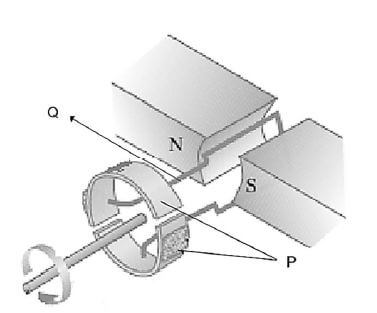
9.1 What type of generator is shown in the diagram? Give a reason for your answer. (2)
9.2 What energy change take place in the generator while it is in operation? (2)
9.3 Name component Q. (1)
9.4 On which principle or law is the working of the generator based? (1) [6]
TOTAL: 150
DATA FOR TECHNICAL SCIENCES GRADE 12
PAPER 1
TABLE 1: PHYSICAL CONSTANTS
| NAME | SYMBOL | VALUE |
| Acceleration due to gravity | g | 9,8 m·s-2 |
| Coulomb's constant | k | 9,0 x 109 N·m2·C-2 |
| Permittivity of free space | ε0 | 8,85 x 10-12 F.m-1 |
TABLE 2: FORMULAE
FORCE
WORK, ENERGY AND POWER
ELASTICITY, VISCOSITY AND HYDRAULICS
ELECTROSTATICS
CURRENT ELECTRICITY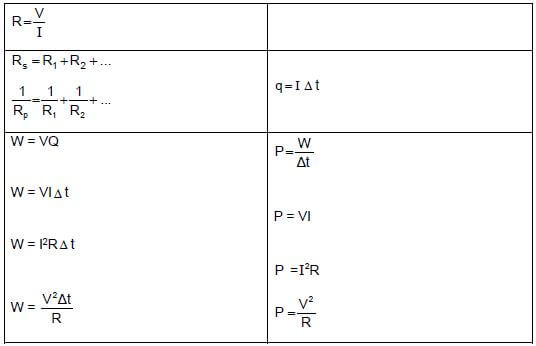
ELECTROMAGNETISM